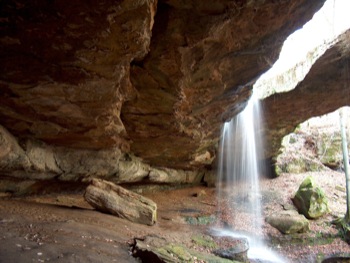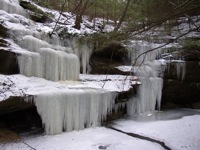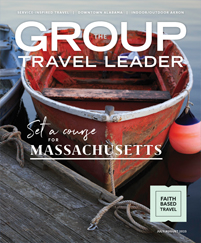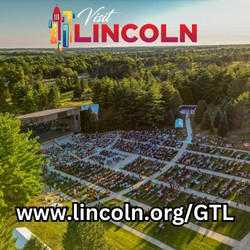
Ohio might not be the first place you would think of if you are looking for rugged and varied scenery and outdoor adventures. However, this Midwestern state known for its farms and large cities has a wealth of scenic attractions, from sandy beaches to rivers flowing through steep wooded hills, from rugged rock formations and deep gorges to rolling hills.
“People think Ohio is all flat farm country. But Ohio’s scenic areas are incredibly diverse,” said Tamara Brown, public relations manager for the Ohio Division of Tourism. “Yes, there is flat farm country in northwest Ohio, but there are rolling Appalachian foothills in the east and southeastern Ohio, charming towns on scenic, meandering Route 52 along the Ohio River and the Lake Erie coastline in the north dotted with lighthouses.”
As varied as the scenic Ohio topography are the ways in which to see and experience that scenery. You can hike, bike or paddle; float on a raft; hop aboard a train or riverboat; don snowshoes or cross country skis in the winter; or if you are adventurous, you can zip high above the scenery.
“Few visitors would probably imagine that Ohio offers rafting adventures on scenic rivers, canal towpath bicycle trails that connect towns and sites of interest, canopy zipline experiences across amazing gorges, hikes to sandstone cliffs overlooks above rushing spring waterfalls or walks through nature preserves full of rare plants and flocks of beautiful migrating songbirds, but if you know where to look, you can find all these opportunities and more in Ohio,” said Brown.
Cliff-top vistas
“When people come here for the first time, they are amazed,” said Karen Raymore, executive director of the Hocking Hills Tourism Association. “People think of the Midwest as being flat. However, the glacier that flattened most of the Midwest stopped just north of the Hocking Hills.
We have some very dramatic caves, hills and waterfalls and some amazing cliff-top scenic vistas. We are in the foothills of the Appalachians, and all the scenery and culture of the Appalachians are part of the region.”
 |
| Courtesy Hocking Hills Tourism Assoc. |
Raymore said there are many natural sites designed for free public access in the Hocking Hills, located in southeastern Ohio between Columbus and Athens, including six sites around the region that collectively are part of Hocking Hills State Park.
Among the scattered sites administered by the state park are Old Man’s Cave, which features waterfalls, swirling pools, deep gorges and massive rock formations; Cedar Falls, a 50-foot falls that is reached through valleys and a steep-walled gorge; Ash Cave, the largest recess cave in Ohio with a 90-foot waterfall; Rock House, the only true cave in the park; and Cantwell Cliffs, a massive overhanging horseshoe-shaped cliff with a sheer drop of more than 150 feet into a gorge.
Brown said groups can arrange for guides in the park “who can show you native wildflowers and even tell the group how Native Americans used various roots and plants for herbal medicines, teas and so forth.
“For those with mobility issues or who cannot hike a more strenuous path with hills and stairs, Ash Cave is an excellent choice,” she said.
The Hocking Hills region also has Lake Logan State Park, which has areas for scenic picnicking and swimming and secluded walking paths; Lake Hope State Park in a rugged, heavily forested area with steep gorges, narrow ridges and ancient mounds; and Tar Hollow State Park with 21 miles of hiking trails along deep ravines and through dense woodlands.
The state’s largest natural bridge is in the Rockbridge State Nature Preserve and the Wayne National Forest is a blend of wooded hillsides and pastureland, along with Adena Indian mounds, covered bridges and the remains of rock iron furnaces.
Raymore said that in an area with such great scenery, “each season is different, and each season is beautiful.”
Even winter holds a special beauty. The annual winter hike from Old Man’s Cave to Ash Cave, held for 45 years in January, draws thousands of people to the state park for a six-mile hike.
“Being in the winter, especially with the snow we have just had, it is beautiful and quite different than what you see in June or July,” said Raymore. “Some of the cave walls are covered with ice spears and some of the waterfalls are frozen. Spring is when the waterfalls are most active in addition to the many species of wildflowers that carpet the forest floors, the migratory birds and the redbuds and dogwoods. Summer is very popular, and then the fall colors are unsurpassed.”
Ohio’s urban outdoors
Ohio’s great natural scenery is not limited to rural areas. The state’s large metropolitan areas also have great opportunities to experience the outdoors, with scenic vistas, native plants and wildlife.
“I live near Pearson Park, and I can literally see the tallest buildings of downtown from the park,” said Scott Carpenter, public relations director for Toledo Metroparks.
 |
| Courtesy Hocking Hills Tourism Assoc. |
Carpenter said Pearson Park combines history and nature. “It was built in the 1930s by the WPA and CCC and still has a lot of that kind of stone work,” he said. “There is a small lake with paddleboats and wonderful trails for walking through old woods. It is part of what used to be the Great Black Swamp.”
Another great natural oasis in the greater Toledo area is Wildwood Preserve, the former estate of the cofounder of Champion spark plugs, which includes his manor house.
“It’s a beautiful natural setting,” said Carpenter. “It’s within the Oak Openings region and has some of the same characteristics, sandy soil with prairie and woods. Also a flood plain of the Ottawa River runs through it.
“You can go from a very scenic stream to walking through prairie to big woods. We also have what we call a Window on Wildlife, where you can sit inside and look out over professionally done bird feeders.
“Both parks are great for bird watching,” he said.
Last year, Columbus opened the Grange Insurance Audubon Center on a peninsula of the Scioto River. “It is the closest Audubon center [in the country] to the heart of a major metropolitan area,” said Scott Peacock, media relations manager for Experience Columbus. “You can see the skyline from the center. It’s just two minutes from downtown.”
The environmentally friendly building has its own geothermal heat, a green roof and recycles its water. “It’s a great birding area,” said Peacock.
Columbus has an extensive and growing system of bicycle paths that connect its city parks.
“We have a good Metroparks system,” said Peacock. “One park used to be the site of an old glacier. It has some great rock formations.”
Known as the Emerald Necklace, Cleveland’s extensive parks system encircles the city with more than 21,000 acres in 16 reservations, the nearest of which is 10 minutes from downtown. It includes miles of walking and hiking trails, eight outdoor educational facilities, seven golf courses and three swimming areas.
Edgewater Park, just minutes from downtown, has a swimming beach and an upper portion with great views of Lake Erie.
“Lake View Cemetery is truly a gem of Cleveland,” said Lexi Hotchkiss, communications manager for Positively Cleveland. “Yes, it seems a bit creepy that I’d recommend visiting a cemetery, but it’s really a beautiful place. It’s located right around University Circle and is considered an outdoor sculpture garden.”
The 285-acre cemetery, founded in 1869, was modeled after the garden cemeteries of Victorian England and France and has a full-time horticulturist.
“The annual blossoming of Daffodil Hill, a collection of more than 100,000 bulbs, an ongoing project since the 1940s, is one of our most popular attractions,” said Hotchkiss.
USA Today has ranked Cincinnati’s parks as one of the top city park systems in the country. It has five regional and 70 neighborhood parks and 34 nature preserves.
One of the most popular is Eden Park, home of the Cincinnati Art Museum, Cincinnati Playhouse in the Park, the Krohn Conservatory and the Hinkle Magnolia Garden, which has a gazebo, memorial tree groves and walking paths.
Twin Lakes, a former quarry, has two lakes, a footbridge and walking paths and a sweeping view of the Ohio River and neighboring Kentucky.
hio might not be the first place you would think of if you are looking for rugged and varied scenery and outdoor adventures. However, this Midwestern state known for its farms and large cities has a wealth of scenic attractions, from sandy beaches to rivers flowing through steep wooded hills, from rugged rock formations and deep gorges to rolling hills.
“People think Ohio is all flat farm country. But Ohio’s scenic areas are incredibly diverse,” said Tamara Brown, public relations manager for the Ohio Division of Tourism. “Yes, there is flat farm country in northwest Ohio, but there are rolling Appalachian foothills in the east and southeastern Ohio, charming towns on scenic, meandering Route 52 along the Ohio River and the Lake Erie coastline in the north dotted with lighthouses.”
As varied as the scenic Ohio topography are the ways in which to see and experience that scenery. You can hike, bike or paddle; float on a raft; hop aboard a train or riverboat; don snowshoes or cross country skis in the winter; or if you are adventurous, you can zip high above the scenery.
“Few visitors would probably imagine that Ohio offers rafting adventures on scenic rivers, canal towpath bicycle trails that connect towns and sites of interest, canopy zipline experiences across amazing gorges, hikes to sandstone cliffs overlooks above rushing spring waterfalls or walks through nature preserves full of rare plants and flocks of beautiful migrating songbirds, but if you know where to look, you can find all these opportunities and more in Ohio,” said Brown.











